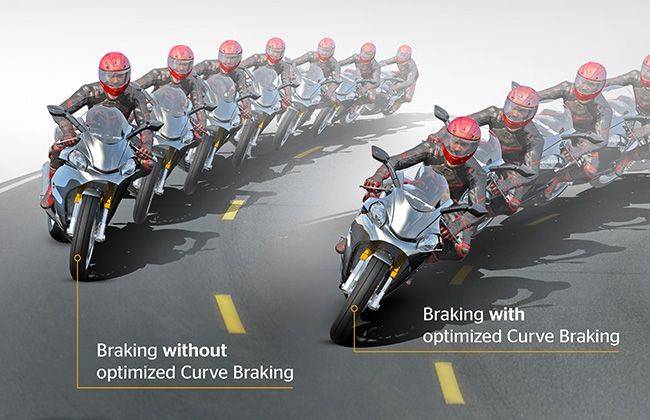Continental develops optimized curve braking for Motorcycle Integral Brake
Published On Nov 14, 2014 12:00 AM By Naveen Soni
- 962 Views
Continental- the International automotive supplier, developing and manufacturing anti-lock systems for motorcycles for more than ten years, has now enhanced its Motorcycle Integral Brake (MIB) system by adding a new function: the optimized curve braking – for safer braking in curves. “Thanks to optimized curve braking, braking in curves is more stable and therefore more predictable. The danger of having an accident in a curve is reduced and safety increased”, said Ronan Le Roy, head of the motorcycle business in the Vehicle Dynamics Business Unit of Continental’s Chassis & Safety Division. The function will go into series production in the new BMW S 1000 XR motorcycle in early summer of 2015.

Up until now, Anti-lock Brake Systems (ABS) for motorcycles have been designed to maintain stability during straight-line braking. Brakes must be applied carefully in curves in order to avoid an abrupt fall. “The system takes account of the fact that a motorcycle banks in curves. The ABS kicks in more gradually, modulating braking pressure more smoothly to improve handling in curves”, said Lothar Kienle, head of Development Motorcycle in the Vehicle Dynamics Business Unit. The Motorcycle Integral Brake system makes sure that brake pressure is applied to both the front and rear wheel in ideal proportion. The result is greater overall stability. The motorcycle translates a rider’s braking intention without a radical shift in weight– a prerequisite for dynamic handling and enjoyment coupled with a reassuring sense of safety.

Optimized curve braking improves handling and enhances safety:
The interaction between numerous sensorics and high-capacity algorithms in a sensorbox is decisive for optimized curve braking. The ABS adapts as a function of how much a rider leans into a curve, depending on the situation. The sensor cluster provides signals on roll and pitch rates plus lateral acceleration to help determine the angle at which a rider is leaning and checks the data around one hundred times per second. As the rider leans more into a curve, the system further limits the speed of the brake-pressure increase at the beginning of braking. The resultant braking pressure accumulates in a more gradual fashion. In addition, the ABS doses modulation more gently. Advantages of the optimized curve braking result in a more sensitive response, greater stability and optimum braking, even in curves for the driver.
The system permits a series of other safety functions that benefit both manufacturers and riders:
- Particularly sensitive lift-off detection for the rear wheel for optimum deceleration and stability (Rear Wheel Lift-Off Protection, RLP).
- Electronic traction control (Traction Control System, TCS) steps in whenever a motorcycle threatens to get out of control due to excess speed, extreme banking or too much slip. Motor management and/or braking reins in power so that a motorcycle can regain stability.
- Wheelie control regulates engine torque to prevent the front wheel from lifting off during acceleration.
ABS - The European Union passes legislation mandating this lifesaver
Anti-lock Brake Systems are just as important to motorcycles as they are to cars so that a vehicle remains stable under emergency braking, the front wheel continues to turn, and the motorcycle does not come to an abrupt fall. “Studies have shown that equipping motorcycles with ABS could reduce accidents by 20 to 30 percent”, said Le Roy. “Universal use of ABS in motorcycles and scooters could greatly reduce the number of serious injuries and accidental deaths”.
The European Union (EU) has already reacted. ABS will become mandatory for motorcycles with more than 125 cc displacement starting January 1, 2016 for newly developed models, and January 1, 2017 for any new motorcycle sold in the EU. The step will give motorcyclists more stability, more control and a big safety plus. Continental is supporting manufacturers and riders with an array of solutions for every class of vehicle. The lineup extends from simple one-channel ABS for scooters and light motorcycles to the Motorcycle Integral Brake system that also offers such enhanced features as sport and off-road ABS, optimized curve braking or Motorcycle Hold & Go.
